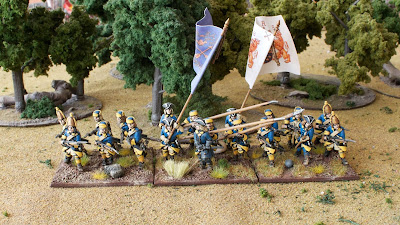Bart Vetters - The Swedish Dal Regementet (Regiment) during the Great Northern War
was one of the 'high profile' regiments that were present in all of the
major battles and spent most of their time, certainly during the 'main
event' of the 1708-1709 Russian campaign, as part of the King's Army.
The were one of the standard 'Indelta' regiments, which were raised from
specific provinces in Sweden, in this case the Dalarna province in
central Sweden. The Indelta regiments (the name comes from the name of
the recruitment system itself, 'Indelningsverket', and has nothing to do
with any river delta anywhere, something that still occasionally
confuses me :) ) were the closest thing to a regular army that existed
at the time of the Great Northern War and were thus ususally the
best equipped and trained.
The Dal regiment was sent to Zeeland with the rest of the King's army and stayed with it until a fateful summer day on the dusty plain near Poltava in the Ukraine. It thus participated in all of the battles of the King's army, including the ones of Karl's 1708 - 1709 Russian campaign (the second and - unfortunately for Karl - a campaign too far). By the time of that campaign, the Dalcarla ('men from Dalarna', and often mistakenly used as the name of the regiment) had obviously become somewhat of a favourite of Karl's - not always a good thing if you're looking for a comfortable spot in battle. At Holowczyn, Karl's favourite battle (it should be - he attacked at night, across a major river, through a marsh against a numerically stronger enemy that had entrenched itself uphill - and won), they were in the first wave, one battalion crossing with Karl himself, a dubious honour shared with only the Lifeguard battalions. At Malatitze a few weeks later, it was the Dal regiment that Karl sent first to aid the Swedish regiments that had been surprised in camp, and it was the only one from the relief force to see actual fighting.
The Dal regiment was sent to Zeeland with the rest of the King's army and stayed with it until a fateful summer day on the dusty plain near Poltava in the Ukraine. It thus participated in all of the battles of the King's army, including the ones of Karl's 1708 - 1709 Russian campaign (the second and - unfortunately for Karl - a campaign too far). By the time of that campaign, the Dalcarla ('men from Dalarna', and often mistakenly used as the name of the regiment) had obviously become somewhat of a favourite of Karl's - not always a good thing if you're looking for a comfortable spot in battle. At Holowczyn, Karl's favourite battle (it should be - he attacked at night, across a major river, through a marsh against a numerically stronger enemy that had entrenched itself uphill - and won), they were in the first wave, one battalion crossing with Karl himself, a dubious honour shared with only the Lifeguard battalions. At Malatitze a few weeks later, it was the Dal regiment that Karl sent first to aid the Swedish regiments that had been surprised in camp, and it was the only one from the relief force to see actual fighting.
At
Poltava, the Dal regiment was in the column of Major General Roos and
was among the units that got caught up storming the Russian redoubts.
They never made it to the main battle, as they and four other battalions
were chased into the woods besides the redoubts, and then all the way
down to a cloister overlooking Poltava itself. Here the remnants of
Roos' group, including the Dal men, eventually surrendered, depriving
the main army of a third of its infantry strength for the main battle.
After
Poltava, the Dal regiment was reraised, surrendered at Tönningen with
general Stenbock and was raised a third time to join in the 1717-1718
Norwegian campaigns that ended with the death of Karl (which to this day
is highly controversial, but that's another story).
Uniform wise, the Dal
regiment is an archetypical Swedish GNW unit: blue coat with yellow
facings, leather vest and breeches and yellow stockings. Headdress is
the equally archetypical Karpus, in this case blue faced yellow. Höglund
notes that in 1707, new recruits sent to the Dal regiment had black
hats (tricornes) and the reraised versions of the Dal regiment also wore
hats instead of the karpus. I have however opted to represent my
Swedish and Russian units as they would have appeared at the battle of
Poltava, and have chosen the karpus for the Dal regiment, conveniently
applying a bit of wargamer's license to forget about the hat wearing new
recruits.
Headwear for the grenadiers is
mostly speculative. While it is more likely that the grenadiers wore
hats just like the other musketeers, references to and examples of
actual grenadier mitres used by Swedish units in the GNW do exist, and
Höglund has the grenadiers of the Dal regiment as wearing 'grenadier
caps of unknown appearance'. In my version of the regiment, I have thus
opted for classical grenadier mitres.
That's all for the Dal regiment. Next is a regiment decidedly unarchetypical, sporting red facings instead of yellow.
References:
The Great Northern War 1700 - 1721, Colours and Uniforms, Lars-Eric Höglund & Åke Sallnäs, Acedia Press, 2000
The Dawn of the Tsarist Empire: Poltava & the Russian Campaigns of 1708 - 1709, Nicholas A. Dorrell, Partizan Press, 2009
The Battle the Shook Europe: Poltava and the Birth of the Russian Empire, Peter Englund, I.B. Tauris, 2003
The
Höglund book is the definitive source on unifoms & flags. The
Dorrell book is very useful for concrete information on troop strengths
& dispositions during the Russian campaign that translate directly
to the tabletop, and the Englund book is the definitive history of the
Poltava campaign.

